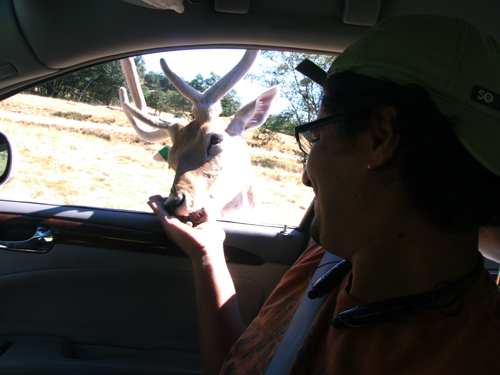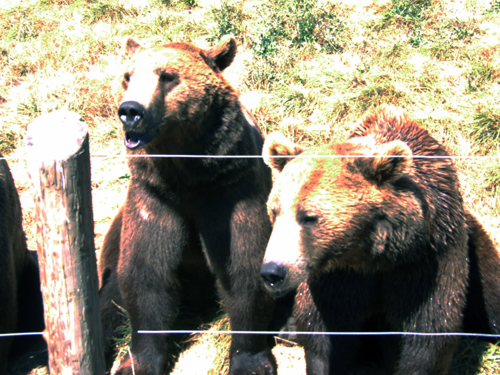
Twenty-Second in a Series
By Donald H. Harrison

WINSTON, Oregon – There’s an oft-told joke that in order to illustrate Isaiah’s well known prophecy (Isaiah 11: 6-9), a zoo exhibited a lion and a lamb together in the same cage. “That’s fantastic!” said one amazed visitor, “Who’d have dared to do such a thing! How do you get them to share the same cage?”
“Easy,” said the zookeeper. “Every morning we put in another lamb.”
I remembered this story while my grandson Shor, son-in-law Shahar, and I were driving through Wildlife Safari here. Most of the herbivores roamed free in the various sections of the park, but for good reason the carnivores were kept in separate enclosures where they could attack neither the herbivores nor us in our cars.
Even so, we did get the wonderful feeling of being close to wild life, or, perhaps I should say in the case of the deer that stuck their heads through our car windows in search of food, the “tame life.”
Wildlife Safari is a non-profit organization that offers numerous up-close experiences with animals. Drive-through viewing has advantages and disadvantages. On the plus side, the animals come right up to your car. If you open your windows (which is permitted), there are no barriers between you and them. On the other hand, without a guide, or signage at stationary locations, it’s difficult for any but zoologists to know exactly what species one is looking at, or what the traits are that make each unique.
Of course, one can take lots of photos and subsequently use the Internet to identify and learn about the animals so pictured.
The basic package at Wild Safari consists of a drive through the 600-acre park at one’s own pace on a 4 ½ mile long road. In addition, there are enhanced experiences offering some up-close encounters with the animals for which one may pay extra.

We had time only for the drive-through and one additional experience in which we came alongside the bear compound. Standing up in the flatbed of Wildlife Safari’s truck, we tossed chunks of apples to the happy grizzly bears. Grandson Shor really enjoyed that. Similar feeding opportunities may be arranged with the giraffes, lions, elephants, and cheetahs. There also are camel rides, picnics at the animal compounds, and other behind-the-scenes visits to choose from.
Of all the animals at the park, the cheetah is the one for which Wild Safari is best known. The park has been breeding the fleet animal since 1972, and at last count over 170 cheetah had been born in the park. Most of them have been placed in zoos throughout the United States. Although they can reach speeds of up to 70 miles per hour, cheetah are threatened in the wild throughout the world. In some two dozen countries of Africa, where the largest populations of cheetah roam, and in Iran, where, reportedly, there are less than 100 Asian cheetah remaining, hunters and farmers are the animals’ biggest enemies.
The hunters want to bag a trophy, whereas the farmers want to protect their livestock, but the effect is the same. Cheetah are slowly disappearing from the wild.
As a member of the Association of Zoos and Aquariums (A.Z.A), Wildlife Safari works with various conservation organizations including the International Elephant Foundation, the Ruaha Carnivore Project, and the Iranian Cheetah Society.
The latter organization is based in Teheran, Iran, and describes itself on its website as follows: “The Iranian Cheetah Society (ICS) is a non-governmental, non-profitable organization in order to save the biodiversity with the Asiatic cheetah as flagship species which is left only in Iran. The ICS is a sophisticated NGO devoted to save the Iranian ‘Big Five’ Carnivores (Asiatic cheetah, Persian leopard, grey wolf, striped hyena and the brown bear) which are normally in conflict with local communities. It has been established in 2001 (registration number 13640) and celebrated its ‘first decade of biodiversity conservation.’
As a matter of due diligence, I made inquiries about the charity based in a country against which the United States has placed sanctions due to its nuclear program.
A spokesperson for the U.S. Treasury Department told me that no sanctions have been placed against the Iranian Cheetah Society, so it is therefore legal to make donations to it. The official made it clear that the Treasury Department, which administers the sanctions program, was not thereby endorsing the society, but rather simply reporting what its status is.
Sarah Roy, chair of Wildlife Safari’s Conservation Committee, responded to my questions in an email. She wrote:
When we started the Conservation Committee here, we tried to focus on more ‘grass roots’ projects that were making the needed efforts, but didn’t quite have their names out yet. We found ICS through one of their supporters and well known cheetah conservation program, Cheetah Conservation Fund. We were impressed with the work that they are doing towards conserving the population of the Asiatic cheetah. With their efforts, they are helping to conserve the last remaining 100 cheetahs within Iran.
This was particularly important to us because from the beginning our facility has always taken pride in our efforts to help conserve both captive and wild populations of cheetahs. We looked further into them and noted that they were supported through AZA, Association of Zoos and Aquariums, the organization that we have our accreditation through. Through AZA, they have been supported through other facilities. We went one step further by speaking to the research project coordinator, Mohammad S. Farhadinia. He was able to provide the specific projects they are currently working on, the public outreach efforts within their local communities as well as a list of where money would be directed to, we are having our donation focused towards camera traps for individual identification within the population and anti-poaching efforts.
With the information that we have found and through communicating with Mohammad, we feel confident that our donations will be going to the intended and proper causes for cheetah conservation.
I must admit that while not all my doubts were resolved, I felt better about the issue after hearing what Wildlife Safari and the Treasury Department had to say.
Nevertheless, I keep thinking about the story of the lion and the lamb.
*
Harrison is editor of San Diego Jewish World. He may be contacted via donald.harrison@sdjewishworld.com